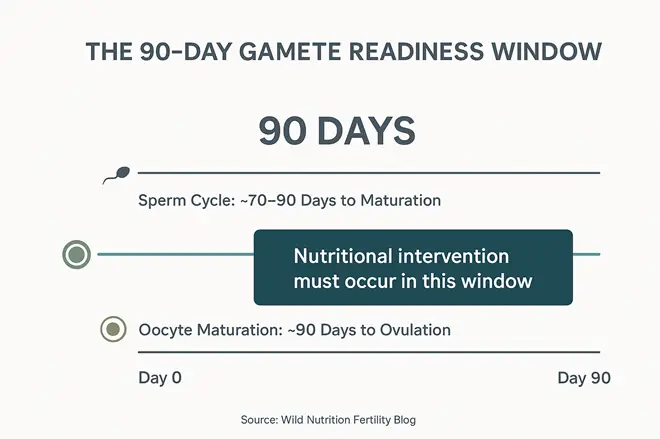

Author : Lorna Driver-Davies, Head of Practitioners, Wild Nutrition
As practitioners, we understand that fertility is not a single event, but a culmination of several months of biological readiness. The two to three months leading up to conception are a critical window of opportunity—not only to establish hormonal equilibrium but, crucially, to optimise the health of the gametes (egg and sperm) and lay the fundamental groundwork for fetal DNA integrity.
This readiness period allows us to move beyond generalised wellness advice and implement targeted nutritional strategies that influence the very building blocks of life.
While male sperm production takes roughly 70 to 90 days¹, the female oocyte (egg) undergoes a final 90-day maturation process before ovulation². This window is pivotal because the health of the oocyte – its energy (mitochondria) and protection (cell membrane)—largely determines the quality of the embryo. Nutritional intervention during this time is therefore non-negotiable.

The oocyte is the largest cell in the human body and is packed with mitochondria, the energy powerhouses. Cell division post-fertilisation is an extremely energy-demanding process.
Clinical Insight: Mitochondrial function is highly sensitive to oxidative stress and relies on specific cofactors. Supporting mitochondrial health ensures the oocyte has the necessary ATP reserves to fuel the rapid cell division required for successful implantation and early development.
Actionable Support: Key nutrients such as Coenzyme Q10 (CoQ10) are essential for the electron transport chain, directly supporting energy production in both ovarian and sperm cells.
Oxidative stress, caused by environmental toxins, diet, and chronic inflammation, is a major contributing factor to DNA fragmentation in sperm and damage to the sensitive cell membranes of the egg⁴.
Clinical Insight: Gametes require a robust antioxidant defence system.
Actionable Support: Targeting the core antioxidants—Zinc, Selenium, and Vitamin E—helps neutralise free radicals. Zinc is vital for sperm structure and testosterone synthesis, while Selenium is necessary for thyroid function and overall cell protection.
The most crucial step in pre-conception is ensuring the integrity of the DNA that will form the new life. This hinges on the methylation pathway.
Practitioners now know that advising “folic acid” is insufficient due to genetic variations (MTHFR polymorphisms) that impair conversion⁵.
Clinical Insight: Methylfolate (5-MTHF) is the metabolically active form of Vitamin B9. Along with Vitamin B12 (as Methylcobalamin), it is central to the methylation cycle, a biochemical process critical for DNA synthesis and repair. Crucially, 5-MTHF does not require activation and is immediately available to mother and fetus⁶.
Actionable Support: Supplementation must provide these bioavailable forms to ensure the successful methylation required for rapidly dividing cells and the correct closure of the neural tube in the early weeks of gestation. Without this, the foundation is weak.
While B-vitamins get the spotlight, Choline is an equally vital nutrient for healthy methylation and structure.
Clinical Insight: Choline is necessary for cell membrane structure (phosphatidylcholine) and supports the methylation pathway independent of folate. Emerging research continues to highlight its indispensable role in placental function and fetal brain development⁷.
Actionable Support: Ensuring adequate choline status prior to and during conception provides an essential layer of structural and metabolic support often neglected in standard pre-natal advice.
The uterine environment must be receptive, and systemic inflammation creates a hostile environment for conception and implantation.
Clinical Insight: EPA (Eicosapentaenoic Acid) and DHA (Docosahexaenoic Acid) are key structural components of cell membranes and potent modulators of the inflammatory cascade. DHA is particularly concentrated in the reproductive cell membranes and is essential for their fluidity and function.
Actionable Support: High-quality Omega-3 supplementation reduces the production of pro-inflammatory eicosanoids (like PGE2), promoting a more anti-inflammatory environment conducive to implantation and healthy pregnancy progression.
Omega-3s are also crucial for supporting hormone production.
Clinical Insight: Cholesterol is the precursor to all steroid hormones, including progesterone. Essential Fatty Acids are required for the efficient uptake of cholesterol into the mitochondria, the first step in progesterone synthesis. Adequate levels are vital for supporting a robust luteal phase.
Translating this complex science into a simple, reliable protocol is the practitioner’s goal. This is where a high-quality, comprehensive formula becomes indispensable.
A foundational product must deliver these critical elements in a highly bioavailable format to ensure the client receives maximum benefit during this limited window.
Wild Nutrition Fertility Support for Women is engineered to meet these clinical demands, providing the essential nutritional platform required for optimal gamete health and fetal readiness:
By establishing a robust nutritional foundation two to three months before conception, practitioners can significantly influence the biological readiness of their clients, promoting optimal fertility outcomes rooted in fundamental cellular and genetic health.






Accepting payments via


YourHealthBasket © 2025
detoxpeople Ltd
Registered in England & Wales 07156741
VAT reg GB 103 3641 60
Our new practitioner portal has been released and it’s now easier than ever to link a client’s account and provide them with suggestions using our new protocol system.
Convert your current cart into a protocol which can then be assigned to a linked client.